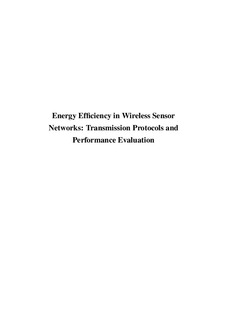| dc.contributor.author | Guntupalli, Lakshmikanth | |
| dc.date.accessioned | 2016-09-05T09:09:08Z | |
| dc.date.available | 2016-09-05T09:09:08Z | |
| dc.date.issued | 2016 | |
| dc.identifier.isbn | 978-82-7117-828-4 | |
| dc.identifier.issn | 1504-9272 | |
| dc.identifier.uri | http://hdl.handle.net/11250/2404216 | |
| dc.description | Doktorgradsavhandling, Fakultet for teknologi og realfag, Universitetet i Agder, 2016 | nb_NO |
| dc.description.abstract | Energy efficiency is one of the major goals for achieving green wireless communications.
The recent growth in ubiquitous wireless connections and multimedia
applications demands higher energy efficiency for wireless communications.
As a part of this picture, wireless sensor networks (WSNs) need to
be more energy efficient since the battery capacity of nodes in such networks
is limited in the absence of energy harvesting sources.
In general, an energy efficient protocol should perform as few as possible
operations when delivering user information successfully across the network.
Energy efficient data transmission schemes could utilize network resources
more effectively to lower down the energy consumption level. In this dissertation
research, we focus on improving energy efficiency for data transmission
and medium access control (MAC) protocols in WSNs. While energy consumption
is inevitable for transmitting and receiving data in a WSN, the other
typical and dominant energy consumption activities are idle listening, overhearing,
and retransmissions due to unsuccessful transmission attempts. An
energy efficient MAC protocol conserves energy by minimizing all these auxiliary
operations in order to prolong network lifetime. On the other hand, balanced
energy consumption among nodes which mitigates energy hole across
a WSN also helps to extend network lifetime.
In this context, we propose two cooperative transmission (CT) based energy
balancingMAC protocols for the purpose of WSN lifetime prolongation.
The first one is an asynchronous cooperative transmission MAC protocol, in
which nodes generate their own wakeup schedules based on their level number
in a WSN topology. The second one is a receiver initiated cooperative
transmission MAC protocol in which the CT is initiated by a relay node. It
is demonstrated that both proposed CT MAC protocols are able to achieve
significantly extended network lifetime.
In addition, an energy conserving sleeping mechanism for synchronous
duty cycling MAC protocols is also proposed in this thesis. It is an eventtriggered
sleeping (ETS) mechanism, which triggers the sleep mode of a node
based on the incoming traffic pattern to that node. The ETS mechanism eliminates
overhearing in a WSN and achieves higher energy efficiency.
Furthermore, we apply packet aggregation at the MAC layer in WSNs for achieving more energy efficient data transmission. In aggregated packet
transmission (APT), multiple packets are transmitted as a batch in a frame
within a single duty cycle instead of transmitting merely one packet per cycle.
Numerical results demonstrate that APT achieves higher throughput and
shorter delay, in addition to higher energy efficiency.
To evaluate the performance of the proposed MAC protocols and transmission
schemes, we develop discrete time Markov chain (DTMC) models
and verify them by comparing the results obtained from both analysis and
discrete-event based simulations. The analytical and simulation results match
precisely with each other, confirming the effectiveness of the proposed protocols
and schemes as well as the accuracy of the developed models. | nb_NO |
| dc.language.iso | eng | nb_NO |
| dc.publisher | Universitet i Agder / University of Agder | nb_NO |
| dc.relation.ispartofseries | Doctoral dissertations at University of Agder; | |
| dc.rights | Navngivelse-Ikkekommersiell-DelPåSammeVilkår 3.0 Norge | * |
| dc.rights.uri | http://creativecommons.org/licenses/by-nc-sa/3.0/no/ | * |
| dc.title | Energy Efficiency inWireless Sensor Networks: Transmission Protocols and Performance Evaluation | nb_NO |
| dc.type | Doctoral thesis | nb_NO |
| dc.type | Peer reviewed | nb_NO |
| dc.subject.nsi | VDP::Technology: 500::Information and communication technology: 550 | nb_NO |
| dc.source.pagenumber | xiii, 205 s. | nb_NO |
| dc.source.issue | 135 | nb_NO |

